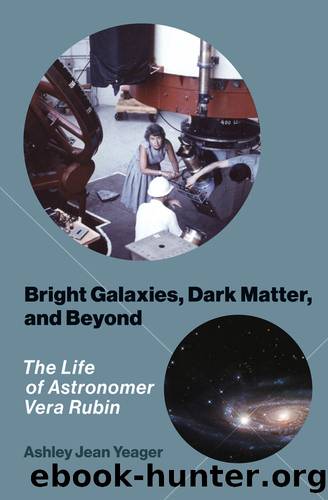Bright Galaxies, Dark Matter, and Beyond: The Life of Astronomer Vera Rubin by Ashley Jean Yeager

Author:Ashley Jean Yeager [Yeager, Ashley Jean]
Language: eng
Format: epub
Tags: Astronomy, science, Biography & Autobiography, Keywords, Space Science, women, Science & Technology
ISBN: 9780262046121
Google: klc5EAAAQBAJ
Publisher: MIT Press
Published: 2021-08-17T00:25:51.895550+00:00
Her contentment may have come from the fact that she and Ford were preparing for one of their first observing runs. It was August 1965, and they flew to Flagstaff, Arizona, to spend a few nights at Lowell Observatory to use their classic 72-inch Perkins reflector. âEarly on, I am sure people thought it was pretty risqué for the two of us to go out into the night to the telescope,â Kent said, âbut we were too focused on making the image tube work and getting data to think much of it.â8
Vera recalled that she did have to assert herself just a bit on that first observing run with Kent. âIt was his instrument, so he had the right to run the first exposure with it attached to the telescope,â she said. As they were setting up for the second exposure, Vera recalled telling him, âNow, itâs my turn.â She said she felt that wasnât easy to do since he owned the spectrograph. Still, Kent understood. After that, they always alternated taking exposures at the telescope.9
Kentâs image tube was particularly good at sensing red wavelengths of light, giving the team an unprecedented view of enigmatic astronomical objects called quasi-stellar radio sources, or quasars. These cosmological beasts stole the scientific spotlight after their discovery in the early 1950s because of how much energy they emitted in radio wavelengths. In fact, they were initially called radio stars because they emitted so much radio radiation and had some features of stars. Quasarsâ optical spectra, finally obtained in the 1960s, revealed the chemical elements of which they were made, but they didnât look like any stellar spectra taken before, so the radio stars were another cosmic mystery.
Slowly, with repeated observations, Dutch American astronomer Maarten Schmidt and others started to piece together a story of what they thought the objects were. Schmidt found the objectsâ spectra were highly redshifted: the lines were positioned more toward the red end of the electromagnetic spectrum. From Edwin Hubbleâs famous observations in the 1920s, astronomers knew that the universe is expanding, puffing out like a balloon. As space-time expands, galaxies not tugged on by galactic clusters move farther and farther apart and farther and farther from Earth, stretching the galaxiesâ light so that when it makes it to our telescopes, it becomes redder. This cosmic expansion appeared to be affecting the light of the quasars, which suggested they were extremely far away. They could be far-off galaxies that outshine any nearby star or galaxy, Schmidt concluded. Not everyone accepted this interpretation of the data, though. Others argued the objects werenât far away at all; but instead were small, bright objects nearby. Time passed, and the debate wore on, sweeping Vera and Kent into the frenzy.
Vera had had an introduction to the quasar debate a little more than a year earlier, in May 1964, when she attended the first Relativistic Astrophysics Symposium in Dallas, Texas. Bob was the one invited to attendâhe was studying energy exchange in atoms at the timeâbut didnât want to go, so Vera went in his place.
Download
This site does not store any files on its server. We only index and link to content provided by other sites. Please contact the content providers to delete copyright contents if any and email us, we'll remove relevant links or contents immediately.
Machine Learning at Scale with H2O by Gregory Keys | David Whiting(4094)
Never by Ken Follett(3758)
Harry Potter and the Goblet Of Fire by J.K. Rowling(3758)
Unfinished: A Memoir by Priyanka Chopra Jonas(3313)
Fairy Tale by Stephen King(3192)
The Man Who Died Twice by Richard Osman(2977)
Will by Will Smith(2766)
Rationality by Steven Pinker(2271)
The Dark Hours by Michael Connelly(2214)
It Starts With Us (It Ends with Us #2) by Colleen Hoover(2171)
The Storyteller by Dave Grohl(2147)
Can't Hurt Me: Master Your Mind and Defy the Odds - Clean Edition by David Goggins(2142)
The Dawn of Everything: A New History of Humanity by David Graeber & David Wengrow(2103)
Friends, Lovers, and the Big Terrible Thing by Matthew Perry(2097)
The Becoming by Nora Roberts(2057)
The Stranger in the Lifeboat by Mitch Albom(2030)
Cloud Cuckoo Land by Anthony Doerr(2012)
Einstein: His Life and Universe by Walter Isaacson(1952)
Love on the Brain by Ali Hazelwood(1931)
